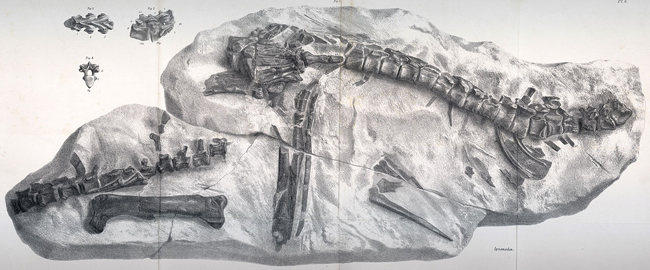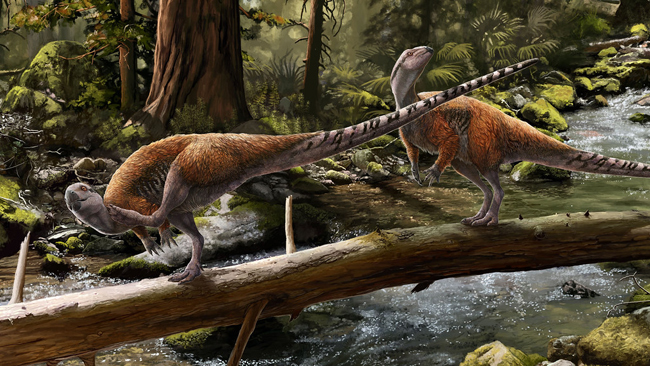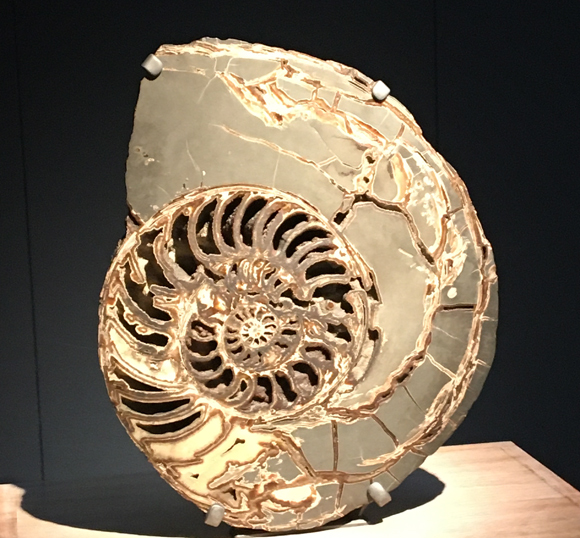Scientists have formally named a new species of hypsilophodontid dinosaur from the Isle of Wight. The new species, named Vectidromeus insularis, is the second member of the hypsilophodont family to be found on the island after Hypsilophodon foxii. This discovery lends weight to the theory that Europe had its own unique biota of small herbivorous dinosaurs, distinct from those found in North America and Asia.
Vectidromeus insularis
Four blocks containing fossil bones were collected at different times from Wessex Formation exposures at Sudmoor Point which is located on the western side of the island about 2 miles (3.2 kms) from the village of Brighstone. The largest block contains hip bones, dorsal vertebrae, a left femur and lower leg bones. The second block contains other parts of the lower leg bones and some tailbones. A third block consists of elements from the right femur and the right tibia. The small fourth block contains the left metatarsals and bones from the toes (phalanges). Blocks one and two come from the same animal and the other fossils can be tentatively ascribed to the same individual.

The fossils represent a chicken-sized juvenile. Vectidromeus may have grown much larger.
Closely Related to Hypsilophodon foxii
The specimen shows numerous autapomorphies that distinguish it from Hypsilophodon foxii. For example, the hip bones are very different. The blade of the ilium is short and deep, and the ischia are more rectangular in shape. The fourth trochanter, a muscle attachment scar on the femur is proportionately larger. As both juvenile and adult specimens of H. foxii are known, the research team confidently stated that these anatomical traits were not due to the dinosaur’s young age. The different characteristics indicate a new dinosaur genus, albeit one closely related to Hypsilophodon.
Dr Nicholas Longrich, from the Milner Centre for Evolution at the University of Bath, led the study. He commented:
“Palaeontologists have been working on the Isle of Wight for more than a century, and these fossils have played an important role in the history of vertebrate palaeontology, but we’re still making new discoveries about the dinosaur fauna as the sea erodes new fossils out of the cliffs.”
Vectidromeus Geologically Much Older than Hypsilophodon
Vectidromeus probably dates from the earliest Barremian or the latest Hauterivian stage of the Early Cretaceous (125-126 million years ago. The H. foxii material from the Hypsilophodon beds higher up the stratigraphic column, lie at the top of the Wessex Formation and are no younger than 121.4 million years. Therefore, as much as 4.6 million years could separate these two taxa.
The Cretaceous strata on the Isle of Wight are hundreds of metres thick and span several million years. Scientific consensus is still not entirely clear how old they are – so the fossils may be sampling a whole series of evolving ecosystems, each with a different set of species.
Co-author on the study, Professor Dave Martill (University of Portsmouth) stated:
“It is utterly bizarre that so many new dinosaurs are being discovered on the Isle of Wight. Vectidromeus is the seventh new species of dinosaur to be discovered in the last four years. This is all down to the amateur collectors.”
It is likely that many new species of dinosaur will be described from fossils found on the Isle of Wight. Palaeontologists are building up a more complete picture of the dinosaur dominated fauna that existed in this part of the world during the Early Cretaceous.

Dozens of small plant-eating dinosaurs have been assigned to the hypsilophodont family, but revisions to the dinosaur family tree have resulted in reclassifying them to other branches of the tree, leaving Hypsilophodon as the only species left in the family.
Dr Longrich added:
“We had a curious situation where one of the first dinosaur families to be recognised had just one species. And now, we have two. What’s intriguing is that they’re not particularly closely related to anything found in North America, Asia, or the Southern Hemisphere. We’re still piecing together how all these dinosaurs are related, and how dinosaurs moved between continents. After Pangaea broke up, there was a lot of isolation, leading to different kinds of dinosaurs evolving on each continent.”
This newly published scientific paper highlights the contribution made to science by fossil hunters and their local knowledge.
Everything Dinosaur acknowledges the assistance of a media release from the University of Bath in the compilation of this article.
The scientific paper: “Vectidromeus insularis, a new hypsilophodontid dinosaur from the Lower Cretaceous Wessex Formation of the Isle of Wight, England” by Nicholas R. Longrich, David M. Martill, Martin Munt, Mick Green, Mark Penn and Shaun Smith published in Cretaceous Research.
Visit the award-winning Everything Dinosaur website: Everything Dinosaur.










Leave A Comment